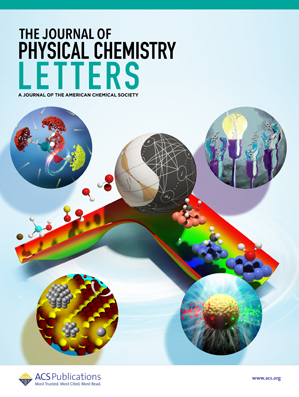Electrically Induced Topological Chirality Switching in Orbital-Engineered Covalent Organic Radical Framework Monolayers.
IF 4.8
2区 化学
Q2 CHEMISTRY, PHYSICAL
引用次数: 0
Abstract
Engineering the topological properties of a quantum anomalous Hall (QAH) insulator is crucial for advancing spintronics and quantum devices. Conventional methods relying on external magnetic fields face limitations in their scalability and energy efficiency. Here, we present the realization of bipolar topological magnetic semiconductor (BTMS) using two-dimensional covalent organic radical frameworks (2D CORFs) based on an orbital-engineering approach. These BTMS host spin-polarized Dirac cones and flat bands with opposite Chern numbers, enabling electrically driven chiral switching of the QAH phase. The triacene(TRI)-CORFs achieve reversible transitions between nontrivial flat-band insulators and QAH phase via carrier doping or heteroatom substitution (e.g., N/B doping), while maintaining robust room-temperature ferromagnetism (TC ≈ 508 K), where the chirality inversion of edge currents is confirmed by Berry curvature analysis. This work establishes 2D CORFs as a versatile platform for electrically tunable topological quantum devices, bridging the gap between organic chemistry and chiral spintronics.轨道工程共价有机自由基框架单层的电诱导拓扑手性开关。
设计量子反常霍尔绝缘体的拓扑特性对于推进自旋电子学和量子器件至关重要。依靠外部磁场的传统方法在可扩展性和能效方面存在局限性。在这里,我们提出了基于轨道工程方法的二维共价有机自由基框架(2D CORFs)实现双极拓扑磁性半导体(BTMS)。这些BTMS拥有自旋极化的狄拉克锥和具有相反陈恩数的平带,使QAH相的电驱动手性开关成为可能。三烯(TRI)-CORFs通过载流子掺杂或杂原子取代(例如N/B掺杂)实现了非寻常平带绝缘体和QAH相之间的可逆转变,同时保持了强大的室温铁磁性(TC≈508 K),其中边缘电流的手性反转通过Berry曲率分析得到证实。这项工作建立了2D corf作为电可调谐拓扑量子器件的通用平台,弥合了有机化学和手性自旋电子学之间的差距。
本文章由计算机程序翻译,如有差异,请以英文原文为准。
求助全文
约1分钟内获得全文
求助全文
来源期刊

The Journal of Physical Chemistry Letters
CHEMISTRY, PHYSICAL-NANOSCIENCE & NANOTECHNOLOGY
CiteScore
9.60
自引率
7.00%
发文量
1519
审稿时长
1.6 months
期刊介绍:
The Journal of Physical Chemistry (JPC) Letters is devoted to reporting new and original experimental and theoretical basic research of interest to physical chemists, biophysical chemists, chemical physicists, physicists, material scientists, and engineers. An important criterion for acceptance is that the paper reports a significant scientific advance and/or physical insight such that rapid publication is essential. Two issues of JPC Letters are published each month.
 求助内容:
求助内容: 应助结果提醒方式:
应助结果提醒方式:


